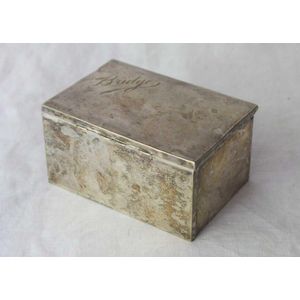Shagreen and Ivory Cigar Box by Calloys of Mayfair
A rare shagreen and ivory cigar box, by Calloys of Mayfair, circa 1910 of rectangular form, the exterior fully veneered in shagreen with ivory stringing, opening to reveal a maple interior with adjustable dividers, the base inset with green morocco leather, bearing the ivory label 'Calloys of Mount Street Mayfair ' 12 cm high, 28 cm wide, 20 cm deep. Property from the Collection of Dame Nellie Melba GBE
You must be a subscriber, and be logged in to view price and dealer details.
Subscribe Now to view actual auction price for this item
When you subscribe, you have the option of setting the currency in which to display prices to $Au, $US, $NZ or Stg.
This item has been sold, and the description, image and price are for reference purposes only.
- Shagreen - Shagreen is the untanned smoothly pebbled textured skins of rays, sharks or dogfish. In finishing, it is dyed, mostly green, but the colour often fades to a cream colour. Shagreen was a popular material in Europe during the Art Deco era, when designers sought to mould the French tradition of luxury with exotic and precious materials. Most collectable items made from shagreen are smaller objects, like glasses cases, dagger and sword hilts, dressing accessories, boxes and picture frames.
- Maple - Maple, native to North America, is a dense heavy timber from light to yellow-brown in colour. It has very little distincive graining unless it is one of the variants such as birds-eye maple or burr maple, so was not used extensively for furniture in 18th and 19th century, where cabinetmakers and designers preferred timbers with more distinctive features such as mahogany, walnut, rosewood and oak.
Birds-eye maple has a seres of small spots linked by undulating lines in the grain, is highly sough and is used as a decorative veneer. Burr maple has larger and irregular grain swirls than birds-eye maple. - Ivory - Ivory is a hard white material that comes from the tusks of elephants, mammoth, walrus and boar, or from the teeth of hippopotamus and whales. The ivory from the African elephant is the most prized source of ivory. Although the mammoth is extinct, tusks are still being unearthed in Russia and offered for sale.
Ivory has been used since the earliest times as a material for sculpture of small items, both in Europe and the east, principally China and Japan.
In Asia ivory has been carved for netsuke, seals, okimono, card cases, fan supports, animals and other figures and even as carved tusks.
In the last 200 years in Europe ivory has been used to carve figures, for elaborate tankards, snuff boxes, cane handles, embroidery and sewing accessories, in jewellery and as inlay on furniture. Its more practical uses include being used for billiard balls, buttons, and a veneers on the top of piano keys.
The use and trade of elephant ivory have become controversial because they have contributed to Due to the decline in elephant populations because of the trade in ivory, the Asian elephant was placed on Appendix One of the Convention on International Trade in Endangered Species (CITES), in 1975, and in January 1990, the African elephant was similarly listed. Under Appendix One, international trade in Asian or African elephant ivory between member countries is forbidden. Unlike trade in elephant tusks, trade in mammoth tusks is legal.
Since the invention of plastics, there have been many attempts to create an artificial ivory - Circa - A Latin term meaning 'about', often used in the antique trade to give an approximate date for the piece, usually considered to be five years on either side of the circa year. Thus, circa 1900 means the piece was made about 1900, probably between 1895 and 1905. The expression is sometimes abbreviated to c.1900.
This item has been included into following indexes:
Visually similar items

A Tasmanian deed box, musk veneered on huon pine carcass, 14 cm high, 33 cm wide, 23 cm deep
Sold by
in
for
You can display prices in $Au, $US, $NZ or Stg.

A sterling silver card box, engraved Bridge, hallmarked London, 1902
Sold by
in
for
You can display prices in $Au, $US, $NZ or Stg.

A Tasmanian huon pine deed box, mid 19th century, 12 cm high, 39 cm wide, 26 cm deep
Sold by
in
for
You can display prices in $Au, $US, $NZ or Stg.

English hallmarked sterling silver cigarette box with engine turned decoration, Birmingham, 1973, maker Deakin & Francis Ltd dimensions 17 x 11.5 x 4 cm
Sold by
in
for
You can display prices in $Au, $US, $NZ or Stg.
